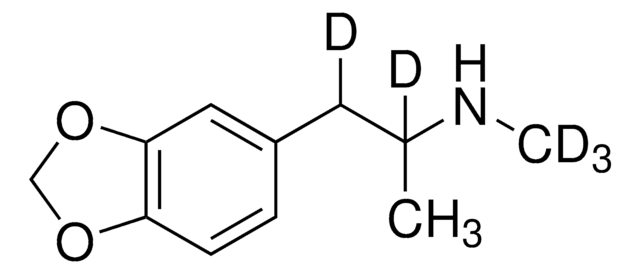F3503
5-Fluoro-2′-deoxyuridine 5′-monophosphate sodium salt
~85%
Synonyme(s) :
FdUMP
About This Item
Produits recommandés
Pureté
~85%
Niveau de qualité
Forme
solid
Température de stockage
−20°C
Chaîne SMILES
[Na].OC1CC(OC1COP(O)(O)=O)N2C=C(F)C(=O)NC2=O
InChI
1S/C9H12FN2O8P.Na.H/c10-4-2-12(9(15)11-8(4)14)7-1-5(13)6(20-7)3-19-21(16,17)18;;/h2,5-7,13H,1,3H2,(H,11,14,15)(H2,16,17,18);;
Clé InChI
DGEOOGBABXVZPJ-UHFFFAOYSA-N
Description générale
Application
- as an anti-mitotic agent for culturing mouse primary cortical neurons.
- as a component of feeding media in the culturing of mouse primary cortical neurons.
- in studies on the activity and function of thymidylate synthase (TS).
Actions biochimiques/physiologiques
Mention d'avertissement
Warning
Mentions de danger
Classification des risques
Acute Tox. 4 Dermal - Acute Tox. 4 Inhalation - Acute Tox. 4 Oral - Carc. 2
Code de la classe de stockage
11 - Combustible Solids
Classe de danger pour l'eau (WGK)
WGK 3
Point d'éclair (°F)
Not applicable
Point d'éclair (°C)
Not applicable
Équipement de protection individuelle
Eyeshields, Gloves, type P3 (EN 143) respirator cartridges
Certificats d'analyse (COA)
Recherchez un Certificats d'analyse (COA) en saisissant le numéro de lot du produit. Les numéros de lot figurent sur l'étiquette du produit après les mots "Lot" ou "Batch".
Déjà en possession de ce produit ?
Retrouvez la documentation relative aux produits que vous avez récemment achetés dans la Bibliothèque de documents.
Les clients ont également consulté
Notre équipe de scientifiques dispose d'une expérience dans tous les secteurs de la recherche, notamment en sciences de la vie, science des matériaux, synthèse chimique, chromatographie, analyse et dans de nombreux autres domaines..
Contacter notre Service technique


